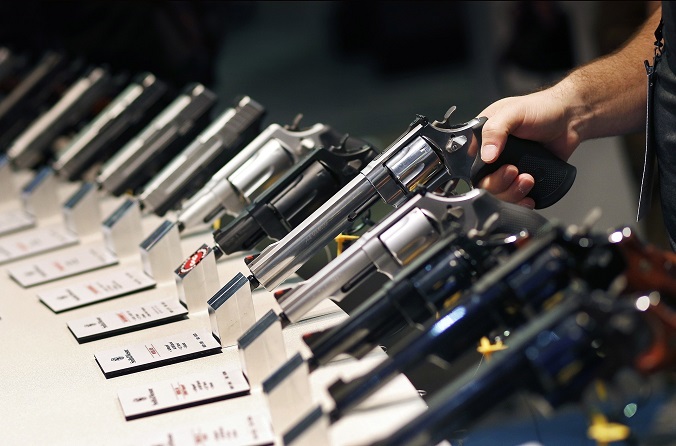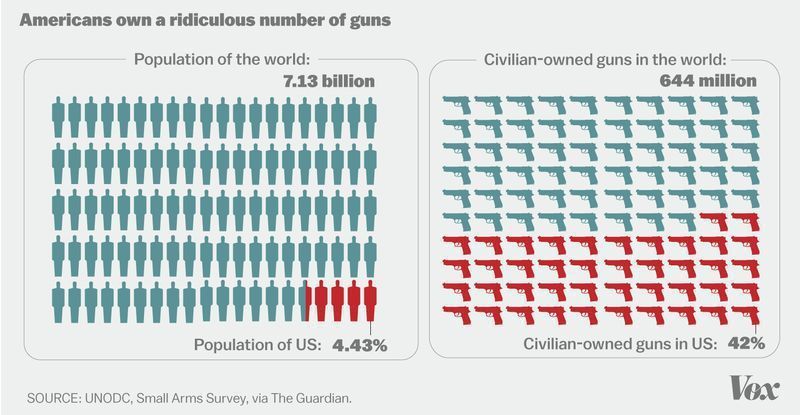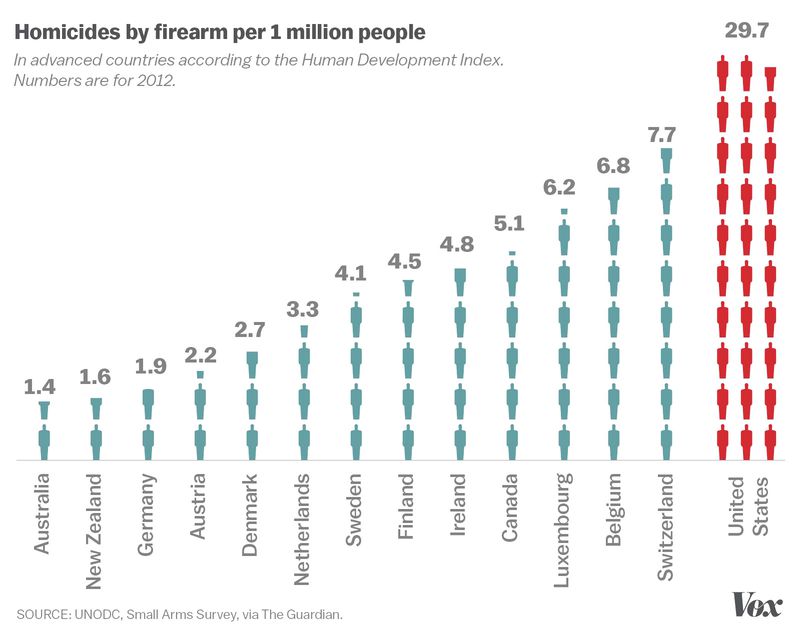The U.S. is the Perfect Test Bed for Gun Reform

Following yet another mass shooting on American soil, the largest since Orlando, the conversation on guns has begun anew. I combed through two recent high profile articles — Leah Libresco’s op-ed at The Washington Post and German Lopez’s response for Vox — that advocate against and for gun control, respectively. Libresco argues that the research on firearm violence is a lot more nuanced than many commentators let on and thus the policy proposals that flow from it may not be the right answer to our problems. Lopez disagrees, contending the balance of data shows that regulating guns consistently reduces gun deaths.
Libresco’s column uses Australia and Great Britain as a springboard, the two countries most often held up as useful analogues for confronting the public health crisis that is gun violence in America. Both countries enacted sweeping reforms in response to mass shootings, including gun buybacks and outright bans on certain firearms. At issue is the extent to which the solutions implemented abroad are mappable to the US situation, and the interpretation of the body of evidence beneath the efficacy of those solutions. It’s clear that Libresco and Lopez each emphasize certain studies over others to prop up their conclusions.
Leaving aside the proper interpretation of any particular study, it seems the most reasonable way to summarize the ensuing discussion is to say that the available data, at least with respect to these two countries and the generalizability of their regulatory programs, are ambiguous. Due to their historically low rates of homicide, mass shootings and gun ownership, post-reform analyses of Australia and Great Britain have run into considerable difficulty teasing out causal relationships. Many of these studies explicitly note the ambiguity in their conclusions, and the ones that did yield statistically significant findings are mum on the principal cause.
Given our ignorance on certain questions relevant to gun violence — some of it by design — does this not signal a need for further research? In the sciences, ambiguous data is an indicator that more research is needed. When faced with equivocal or inconclusive results in climate science, for example, we don’t sit on our hands and say “come what may.” We get back to the bench.
And if we look at the reasons often cited for disanalogizing the US from Australia and Great Britain, they uniformly suggest the US would be much better suited for yielding tangible, statistically significant results. Neither Australia nor Great Britain were burdened by an anomalous gun culture, so ownership rates were relatively low even before regulations were turned on.
By contrast, we have the most guns (300 million+ according to a 2009 estimate by the Bureau of Alcohol, Firearms and Tobacco, or 90 per 100 people, 35 more than second place Yemen at 55 per 100), the most gun homicides (29.7 per 1 million people), and the most mass shootings (31% despite being just 5% of the global population), all of which should render fruitful A/B comparisons. And the rate of mass shootings in the US is on the rise, now more than triple that of 2011.
The stubborn “gun rights” crowd is quick to poke holes in broad-based comparisons but seems comfortable with the status quo. It reminds me of the climate faux-skeptics who claim the science isn’t settled, yet insist we take take away funding for research. If you’re willing to point to problems in data quality, you should also be willing to support additional research. Indeed, the best way to remedy the situation is to test untried policies in a domestic context.
With that said, there actually has been extensive research on gun control measures both in the US and abroad that isn’t hampered by the set of limiting considerations that plague research on Australia and Great Britain, as Lopez drives home in his piece. Research in the US has been conducted by a host of public and private groups that gather not only nationwide statistics but state-level comparisons as well. (It’s primarily the CDC and NIH that have been hamstrung in gun-related research.)
We have ample evidence that shows where there are more guns there are more homicides — even after controlling for known variables like population, economic outcomes, rates of mental illness or alcohol consumption, stress level, rates of urbanization, and non-firearm related crime — as well as accidental firearm deaths. We also have ample evidence that states with stricter right-to-carry (RTC) laws (NY, CA) have less gun violence and have seen sharper declines in gun violence in recent decades compared to states with more lenient RTC laws (Nevada).
Disregarding the obvious difficulties involved in replicating preferred foreign policies amid the legislative gridlock of Washington, what exactly have we got to lose by trying some of the many sensible solutions that have been proposed? Sure, responsible gun owners will be inconvenienced by a more arduous process of getting their hands on guns and ammo. But so will folks like Stephen Paddock, who acquired his arsenal of destruction through entirely legal means, amassing some 33 firearms over the course of a year. This would have raised all kinds of red flags in any other developed country, but apparently not here. And this has always been the driving intent behind sane and sensible gun control — to increase the barriers to ownership and ensure a larger population of gun owners are responsible and properly trained.
It seems to me the US is the perfect case study for gun reform. We have every reason to believe that our massive gun violence malady is intimately connected to our exceptional rates of gun ownership. We just can’t say for sure how effective the solutions enforced abroad would be here, because they’ve never been tried on anything like this scale before. But if there’s one thing both sides of this debate should be able to agree on, it’s that we’d like to have more and better data and save as much innocent life as possible.
We have a choice: we can recruit political capital toward meaningful action in this space, or we can continue to bide our time as the gun lobby plays out its agenda. We’re running an experiment either way — one that involves tens of thousands of lives every year.
Further reading:
- Gun violence in America, explained in 17 maps and charts
- America’s gun problem, explained
- More guns mean more gun murders. Here’s how we know.
- There’s scientific consensus on guns — and the NRA won’t like it
- 1,516 mass shootings in 1,735 days: America’s gun crisis – in one chart
- 511 Days. 555 Mass Shootings. Zero Action From Congress.
- Mass shootings are an American problem. There’s an American solution.
- As a Japanese Man Living in America, Gun Violence Is My New Reality
- More Guns Do Not Stop More Crimes, Evidence Shows
- Do Armed Civilians Stop Mass Shooters? Actually, No.
- 10 Pro-Gun Myths, Shot Down
- How to Reduce Shootings
- The biggest questions about gun violence that researchers would still like to see answered
- Gun research faces roadblocks and a dearth of data
- The Gun Debate: What Everyone Needs to Know
- Suicide Differences by Region Related to Gun Availability
This post was featured on HuffPost’s Contributor platform.
Feature image credit: John Locher / AP




Comments